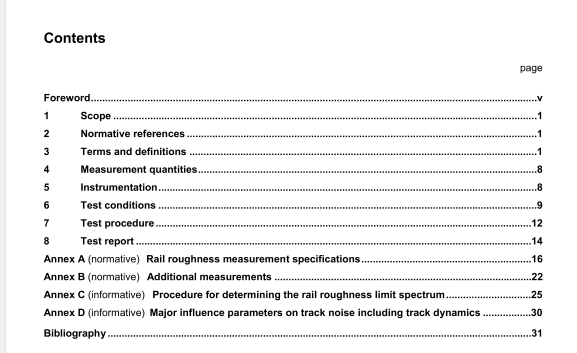ISO 3095 pdf download – Railway applications – Acoustics —Measurement of noise emitted by railbound vehicles.
4.5 If frequency analpis is required, it shal be made at least in one third octave bands according to EN ISO 266: a typical frequency range could be 31.5 Hz to 8 kHz. It is important however, that the lower frequency limit Is chosen to ensure that the product of the lowest bandwidth and signal duration exceeds unity.
4.6 In presence of noise with suspected tonal character, at each microphone position It is suggested to make frequency analysis measurements according to 4 5
Currently no method exists to measure simply the tonal character of the noise from passing trains:
conventionally, if the level of one frequency band exceeds the level of the arithmetic mean of its adjacent bands by more than 5 dB the tonal character may be confirmed: this method should be used when there are no other national methods for the evaluation of pure tones.
4.7 For measurerrients on stationary vehicles, In presence of noise with suspected impulsive character, at each microphone position it is suggested to make two measurements: one with time weighting S (slow), the other with time weighting I (impulse) (see EN 61672.1).
Currently no method exists to measure impulsiveness of the noise from passing trains: conventionally, if the difference between the two s more than 5 dB the impulsive character may be confirmed; this method should be used when there are no other national methods for the evaluation of Impulsiveness.
4.8 Additional measurements on stationary vehicles, at platforms and stopping points and on bridges are described In Annex B.
5 Instrumentation
The Instrumentation system, including the microphones, cables and recording devices shall meet the requirements for a type 1 instrument specified in EN 61672-1.
The microphones shall have an essentially flat frequency response in a free sound field.
The 113 octave band filters shall meet the requirements of class 1 according to EN 61260.
A suitable windscreen shall always be used.
6.3.4 Measurements on accelerating from standstill or decelerating vehicles
The vertical and lateral positions of the set of microphones are identical for all types of accelerating from standstill and decelerating tests and are Identical to the positions descnbed in 6,3.1 at 7,5 m from the track axis only.
The nisnber of sets and their longitudinal position, i.e. the distance ahead of the front of the train at the moment when it starts accelerating or braking, depend on the type or train.
Given L the distance between the bogie centres of the vehicle, the sets of microphones will be placed:
a) one set 20 m ahead of the front of the train in the case of an indMdual powei- unit accelerating;
b) two sets, one at the front of the train and the other at L12 m ahead of the front of the train, in the case of accelerating trains with distributed power or of decelerating trains of any kind.
The measurement shall end when the end of the unit is 20 m past the last set of microphones. For acceleration test, the measurement shall be stopped when either the rear of the power unit is 20 m past the last set of microphones or the speed exceeds 30 kmTh.
6.4 Vehicle conditions
6.4.1 General
The vehicle shall be in Its normal operating conditions end, for test with constant speed, Its wheels shall have run in normal conditions at least 3 000 km (or 1 000 km for tramways and metros) on track with normal traffic For vehicles with tread brakes and blockftread pair shall be i ground conditions (a run-in condition where block and tread have ground themselves sufficiently). The wheel treads shall be as free as possible from irregulanties. such as flats
When trailed vehicles are to be tested, all efforts shall be made to ensure that the measurements are not Influenced by noise from other parts of the train, like power unit adjacent vehicles.
6.4.2 LoadIng or operating conditions
The vehicles shall be unloaded or unoccupied except for the train crew. For power units (for example
locomotives), their normal load under working conditions (tractive effort) shall be used
6.4.3 Doors, wIndows, auxilIary equipment
Durwig the measurements, the doors and windows of the vehicle shall be kept closed,
Auxiliary equipment on the test vehicle that normally operates during the run shall be In action. However, if the auxiliary equipment noise appears infrequently for only a short time (less than 2 % of the operating time).
ISO 3095 pdf download – Railway applications – Acoustics —Measurement of noise emitted by railbound vehicles
